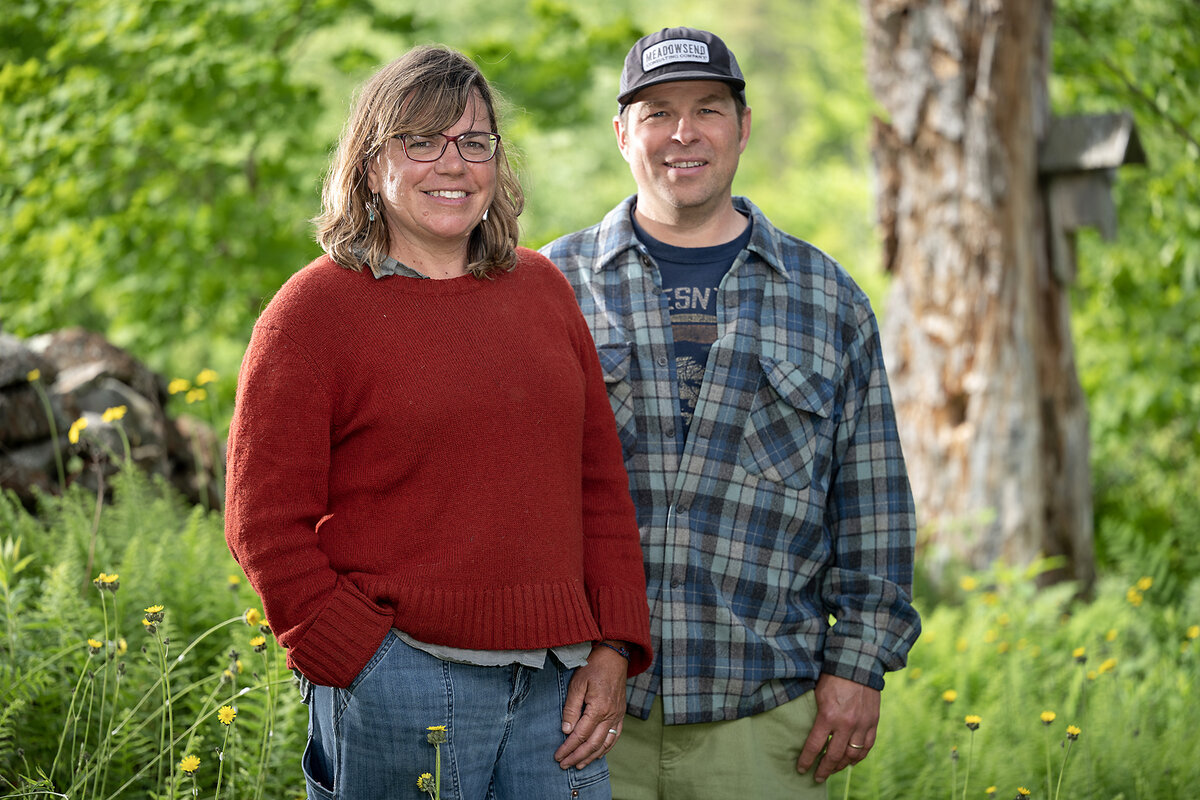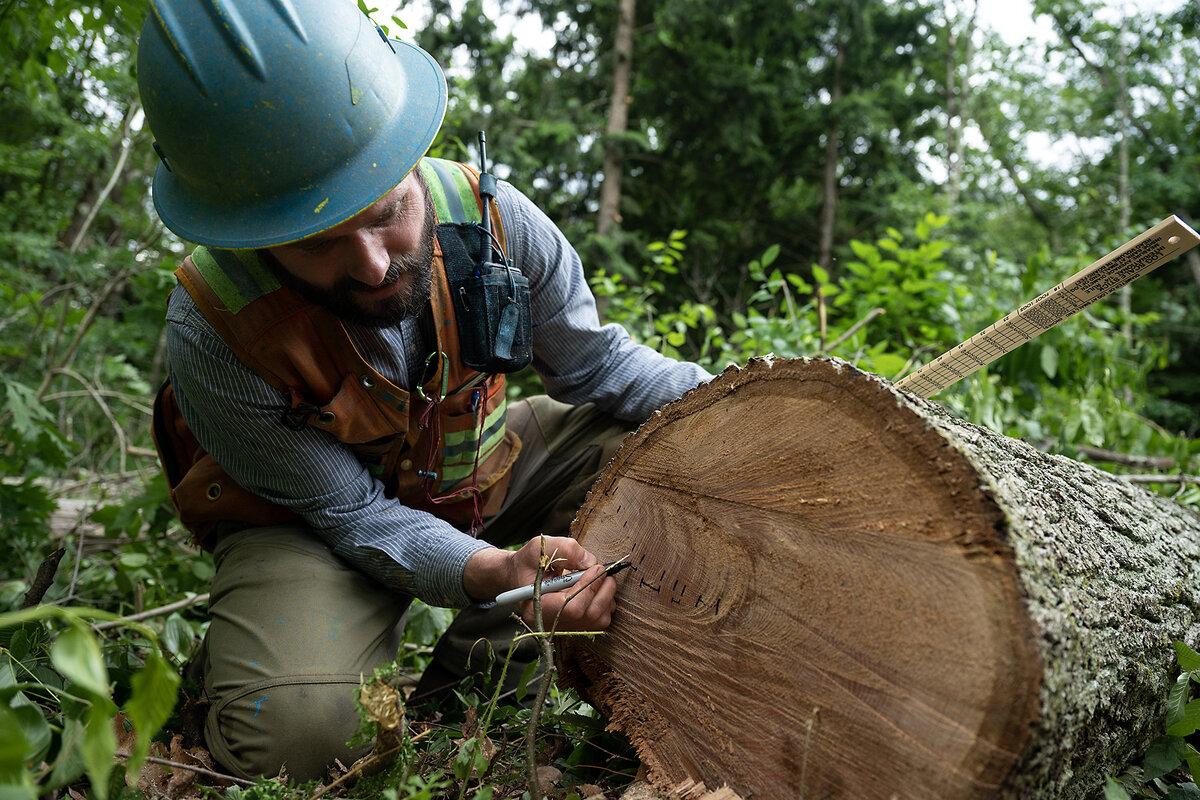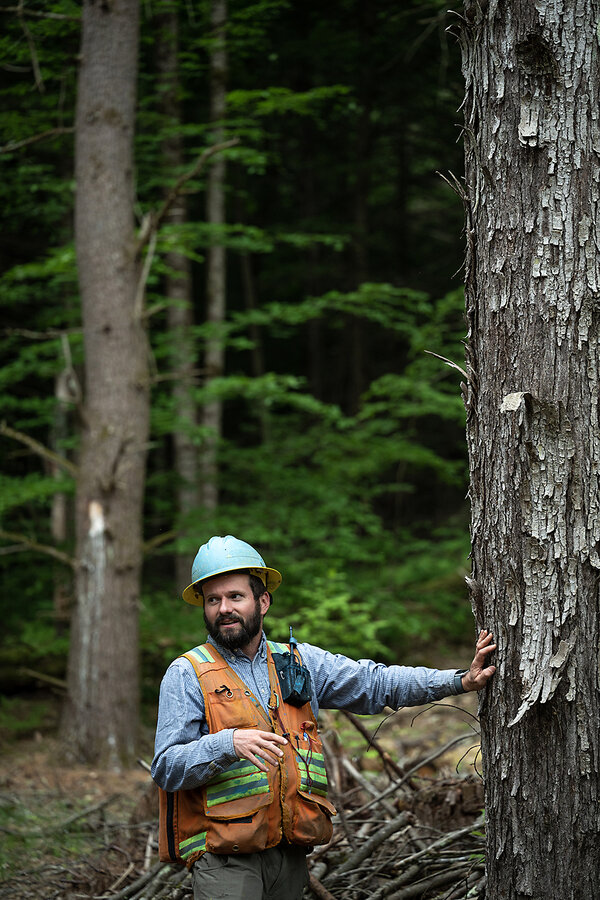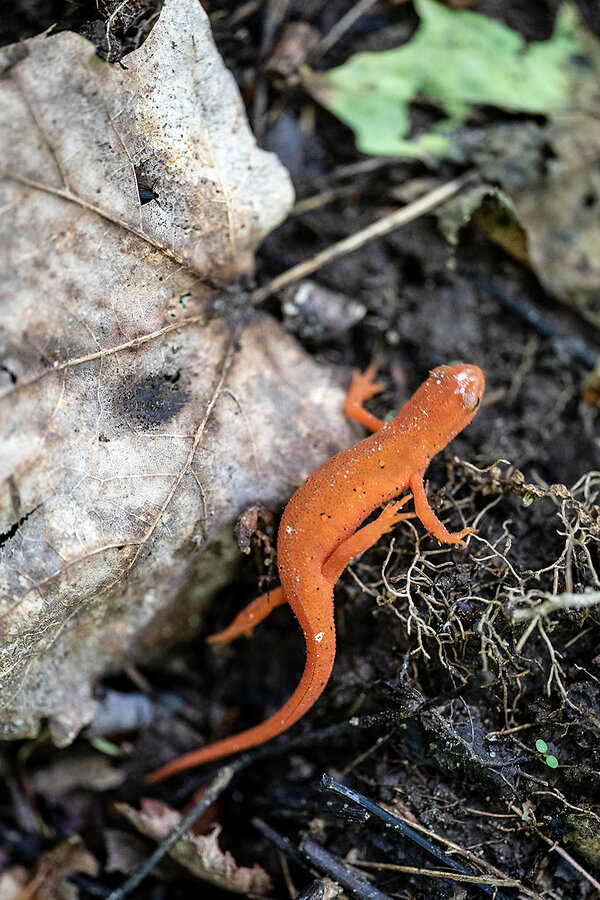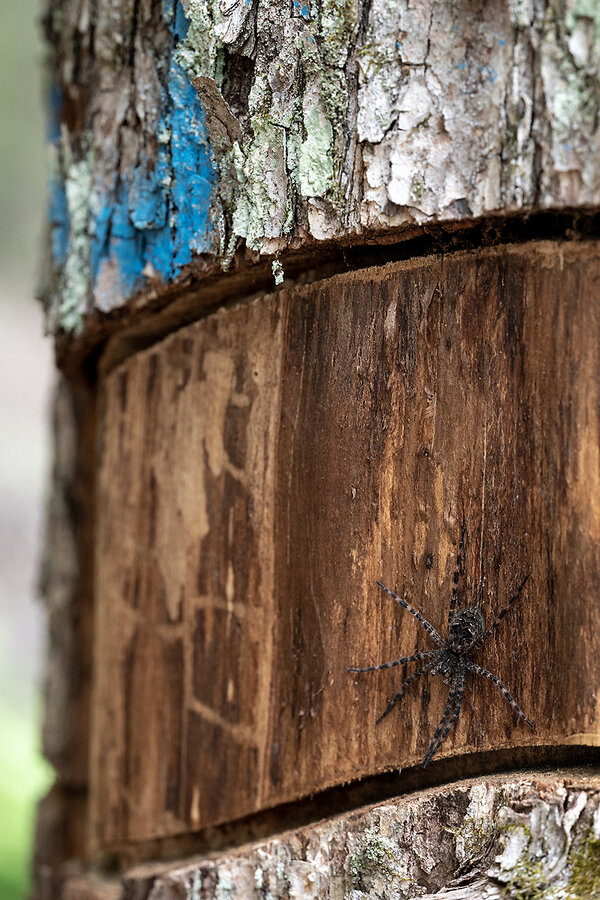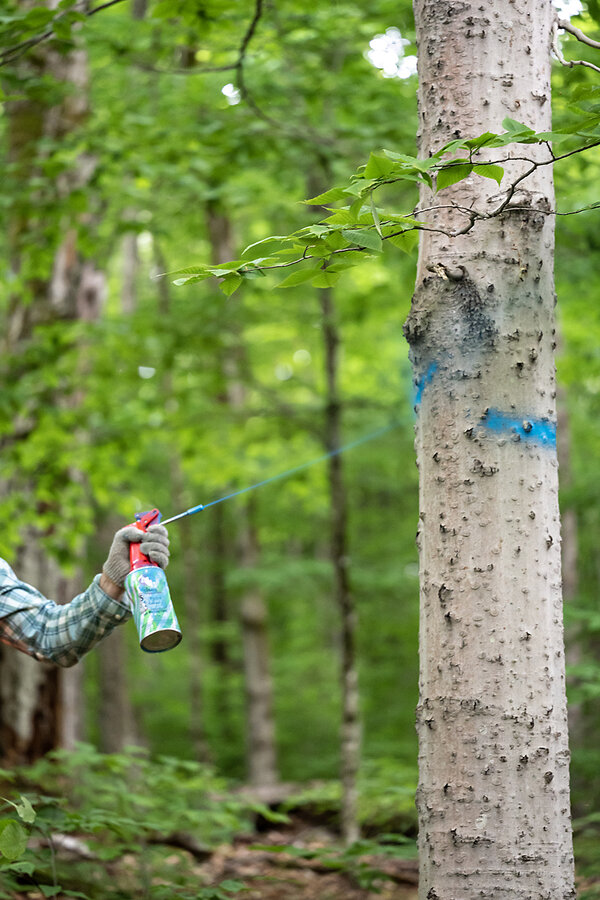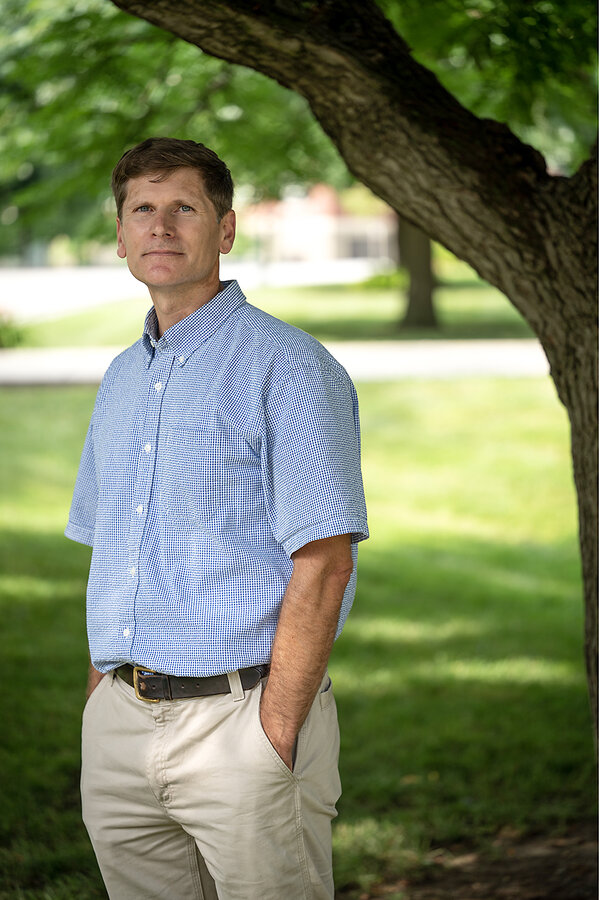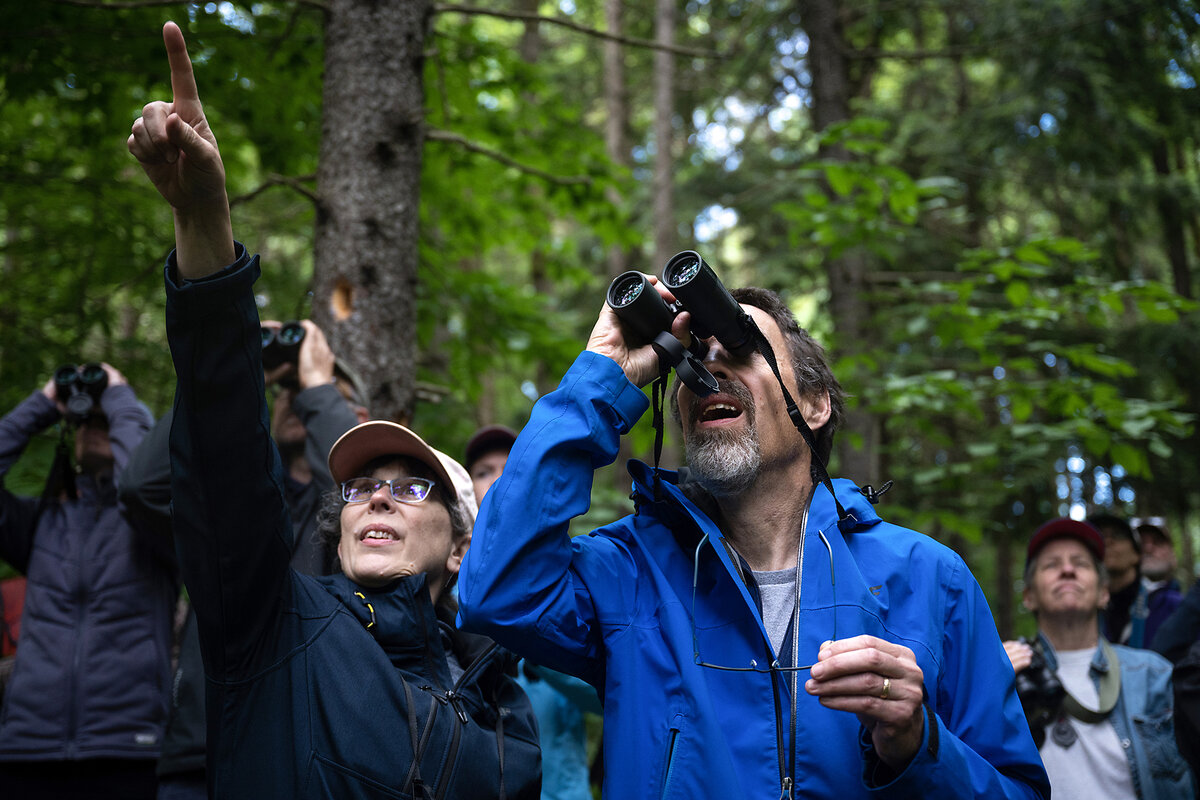To hug or to cut? A new generation of foresters says do both.
| Unity, N.H.
Jeremy Turner loves trees, especially an old red pine that stands in the forest a few hundred yards from his house. There, each year, black bears stop to make their mark. They rub their shoulders against it. They scratch its bark with their long claws.
On a recent spring morning and in the absence of bears, Mr. Turner demonstrates. He shimmies like an Ursus americanus rubbing its back against a tree while a handful of visitors look on in fascination.
“Walking with bears is what I like to do,” he tells them. “It’s kind of a sacred process.”
Why We Wrote This
A story focused onAmerican forestry has been a stage of conflict between timber interests and conservation. A new generation of ecological foresters wants both to flourish.
Mr. Turner may be part bear, but he is all forester. The old pine was one of the trees still standing after he cut others down to create a small opening in the forest.
The omission was not accidental. He and his wife, Laura French, are professional foresters. They live on 330 acres in the low mountains of southwestern New Hampshire, land that long ago was cleared for a hilltop farm, and then abandoned. In time, the forest reclaimed the land.
Since they moved here 15 years ago, they have tried to harvest trees in a way that encourages the ecological diversity and complexity one might find in a much older forest. This includes not just trees but all forms of life, including plants and animals above the ground and below.
“We’re trying to promote an enhanced level of diversity and complexity,” Mr. Turner says. “That’s going to create a healthier system. It’s also going to create a more dynamic system that can react to whatever is coming.”
This approach is part of a growing trend in American forestry. Like Mr. Turner and Ms. French, more and more landowners, foresters, and overseers of public lands are trying to manage forests with the aim of promoting the values of ecology, a branch of biology that’s the study of the vital connections among plants and animals in a given place, and not simply the economics of harvesting timber.
This new approach is rooted in efforts to reconcile what has long been seen as competing goals in American forestry: harvesting timber and protecting forests. Advocates recognize the need for wood products. But they say cutting trees down doesn’t have to diminish the forest. If done well, they say, it can make the forest better.
“Forestry for the last 100 years was based on the principle of sustained yield,” says Geoff Jones, a forester in Stoddard, New Hampshire, and former director of land management at the Society for the Protection of New Hampshire Forests.
“You don’t cut more than you grow in the year,” he says. “You’re not cutting your principle. It’s a good, valid concept, except it doesn’t take into consideration all the other things that take place in a forest that have to do with animals, birds, insects, mycorrhizae, fungi, biodiversity, all that stuff.
“Ecological forestry looks at sustaining the ecological processes that sustain the yield of timber,” he continues. “It’s a subtle, but very significant, shift.”
Also known as “ecological silviculture,” these ideas also focus on helping forests recover from past abuse – which most forests in the United States have sustained, ecologists say. It also helps them adapt to what may be a bigger challenge: climate change.
Mr. Turner and Ms. French have practiced ecological forestry in different ways. They’ve cut some trees but left many others, including older trees that will live out their lives in the forest. They’ve left dead trees standing for the use of insects and birds, and allowed fallen limbs and trunks of trees to decay on the forest floor. They’ve created openings in their forest, trying to imitate natural disturbances that allow sun-loving trees and plants to grow and diversify the forest. They’ve left other areas undisturbed.
The couple have also cut species that are struggling because of global warming, such as spruces and sugar maples. They’ve spared “generalist” trees with the ability to adapt, like red oaks. They’ve planted acorns. Their goal, Mr. Turner says, “is to leave the forest better than we found it.”
And his clients? What do they think? “People are very much interested in this approach,” he says. “More so than ever.”
An old idea, newly embraced
Ecological forestry goes back to at least the 1980s, when Jerry Franklin, a prominent forest ecologist in Oregon, wrote an article in American Forests magazine calling for “a new forestry.” He described it as “a kinder and gentler forestry that better accommodates ecological values, while allowing for the extraction of commodities.” Mr. Franklin, who had grown up in a Washington mill town, says foresters should strive to “maintain the complex forest ecosystem, not just grow trees.”
Mr. Franklin was reacting to forestry practices after World War II, when the timber industry was cutting forests heavily to meet the demands of an expanding economy. He was also writing at a time of growing public concern about the environment, including about the endangered spotted owl. Conservation organizations like The Nature Conservancy were also growing in size and influence at the time. States were starting to adopt forestry rules.
Since then, the growing popularity of land trusts, timber certification programs, federal conservation grants, and carbon sequestration credits has offered new avenues for protecting and improving forests.
Other trends are making it more difficult, however. In recent years the forest commodities industry has globalized and consolidated. As a result, industrial forestland in the U.S. – which is about 20% of the country’s forests – is now mostly owned by private investors, not by wood products companies. This has created greater economic pressure to maximize short-term shareholder profits.
“The investors I’ve talked to, they buy land knowing they’ll own it for five to eight years,” says Klaus Puettmann, a forest ecologist at Oregon State University. “You do things different if you think you’re going to own it five to eight years than if you’re going to own it 50 to 100 years.”
But ecological forestry has gained ground on public lands, including forests managed by federal agencies like the U.S. Forest Service and Bureau of Land Management as well as state agencies like the Wisconsin Department of Natural Resources.
Small landowners, too, are embracing it. The U.S. has 800 million acres of forest, and about two-thirds of it is privately owned. Of this, more than half belongs to small landowners. Foresters say a new generation of these landowners cares less about income from forests and more about wildlife, recreation, and ecology.
Dr. John Bassi is one of them. He’s the medical director at St. Paul’s School, a secondary boarding school in Concord, New Hampshire. Some years ago he and his wife took over responsibility for a 478-acre forest their family has owned in the Mink Hills of central New Hampshire.
One of the first things Dr. Bassi did was to ask Mr. Turner’s company, Meadowsend Consulting Co., for a management plan. What he got was more than a dry accounting of species within it and the potential commercial timber it might have.
“It was a love letter to the forest,” Dr. Bassi says.
He recalled this happily as he strode up a rough logging road, his shaggy golden retriever Luca trotting alongside. Limbs of maples and beeches and other trees stretched over his head. Stands of hemlocks and spruce stretched deep into the woods.
Three years earlier, loggers had come in and cut a “little bit of everything,” he says. It was enough “to meet expenses.” They also cut small openings, and Dr. Bassi paused at some of them to survey the new growth. “It’s really greening up,” he says of one. He stopped to admire a big beech the foresters had left standing.
“They left a lot of oaks and birches, too,” he says. “That’s more for deer to eat.” Dr. Bassi is a hunter, and he hopes the new management plan will increase the number of animals in his forest – not just deer but also turkeys and bears. But what he liked most was how it reflected both his love for the forest and his sense of responsibility for it.
“I always think I’m steward of the land for just a short period of time,” he says. “What I’m trying to do is maintain it for the next generations.”
Cutting trees with restraint and care
In practice, this means cutting trees with restraint and care. Still, ecology has never been absent from the concerns of U.S. foresters. But advocates of ecological forestry say it has usually taken second place to economics. Traditional forestry, they say, has prized simplicity and regularity over ecological complexity.
Its model has been agriculture. The most obvious examples are the pine plantations of the South or the Douglas fir plantations of the Pacific Northwest. But the agricultural approach has also led to the overharvesting and simplifying of other forests, they say. Landowners look for “even-aged stands” – sections of valuable trees of the same size that are more efficient and more profitable to harvest.
Ecological forestry, they say, takes the forest itself as the model. Not necessarily what it was or is now, but what it might be. In practice, this means protecting streams, promoting carbon sequestration, and encouraging the continuity of forest life. It means increasing diversity and complexity across the forest, including trees of different species and different ages. It means fighting invasive species. Increasingly, it means responding to climate change.
Advocates of ecological forestry are using many strategies to do this. One is to nurture a variety of tree species in a forest and not just those most valuable on the timber market. In a mixed hardwood forest in southern New England, this might mean sparing black cherries in a forest where maples abound. In the Pacific Northwest, it might mean letting hardwoods grow in a conifer forest.
“I find myself advocating things almost heretical,” says Mr. Jackson, the Oregon ecologist who remains a leading figure in forestry today. “We need to incorporate hardwood trees in our forest of Douglas firs. They’re much more conservative of water than evergreen conifers.”
But two strategies stand out. One is to preserve “biological legacies,” such as standing dead trees. Foresters call them “snags,” and they serve as hosts to fungi, insects, birds, and other forest life. Biological legacies also include living trees that are left to grow to maturity and old age. Old trees add to the continuity and genetic diversity of forest life above ground and in the soil.
The second strategy is to mimic natural disturbance. Nature is not always gentle. Far from it. Disturbance and disruption are as much part of forest life as the slow growth of an old pine. In the West and Southeast, disturbance often means fire. In the Northeast, it more often comes in the form of wind and ice storms. These disturbances increase biodiversity by allowing new, sun-loving herbs and shrubs and trees to grow up even in the middle of a dense forest. Indeed, an old forest is not one thing but a mosaic of old trees and young, deep woods and sunlit openings, the product of long steady growth but also moments of small-scale destruction.
To imitate these disturbances, foresters cut small openings in the forest, sometimes called “patch cuts.” Patch cuts are not clean or neat. They are left scattered with standing trees, living and dead. They are often filled with the leftover limbs of trees that have been harvested. They’re a mess.
“It’s as messy as we can make it,” says Alex Barrett, a Vermont forester standing in a timber-strewn patch cut not far from the Connecticut River.
It was a jumble only an ecological forester could love, full of downed trees and branches but with plenty of trees left standing, both living and dead. Mr. Barrett’s company, Long View Forest, had removed two loads of logs, mostly pine. “This is very nontraditional forestry,” Mr. Barrett says.
The patch cut was a small opening in a much larger forest of pines and hardwoods, including oaks and maples. Some of the trees left standing had been spray-painted with a big blue G. These trees had been “girdled” with a chain saw and left to die. Others had been spray-painted with a blue L – the mark to “leave it be.”
One tree marked with an L is a big ash. Foresters usually cut ash trees because an invasive insect, the emerald ash borer, is killing most of them. Leaving one alive was a gesture of hope.
“Hopefully we’ll get a bunch of ash seedlings out here,” Mr. Barrett says.
A lot was happening already. A tiny eastern wood pewee, a bird that flourishes in forest openings, flits between trees still standing in the patch cut. A broad-winged hawk swoops past. Below, the ground shimmers with the delicate green of new foliage. Mr. Barrett drops to his knees to take a closer look.
Most of the delicate plants were seedling trees just getting their start. “This is birch,” he says, fingering the leaves of one. “This is a red maple,” he says of another. “This is rubus – it’s a blackberry.” Birds would love the blackberries, he says. Finally he rises to his feet.
“The more you stay here, the more you find,” he says. “Now that it’s wide open, it’s going to be a party.”
Earlier in the day, Mr. Barrett visited another forest where a co-worker was marking trees for timber cutting. There would be no patch cut here. As in most forests, they would be cutting trees selectively, one here and there. The question was, Which ones?
As they made their way through the forest, pushing through ferns and underbrush, Mr. Brennan continued to mark various trees, reaching high to spray a long blue line across the trunk. Sometimes he paused to contemplate what should be done to them. He sprayed a forked red maple with old wounds, but left a bigger maple untouched.
“If you value purely economics, that tree gets cut,” Mr. Barrett says. They also left a tall, old white pine that soared above the forest canopy. Its presence suggested that an earlier forester had been thinking ahead, too. “This is a legacy tree that 40 years ago they didn’t cut,” Mr. Barrett says. “They were thinking of seed, thinking of the future.”
“Let nature do its thing”
Interest in a “kinder and gentler” forestry is not limited to the U.S. Europe has a long history of efforts to find alternatives to clear-cutting and plantations. One that’s become popular in recent decades is close-to-nature forestry. This approach has aims that are ecological, but it’s more restrained than American-style ecological forestry. Instead of disturbance, it emphasizes continuous forest cover. Trees are cut sparingly, sometime just one per acre. Natural processes are valued above all. There’s no planting of trees, no using herbicides to kill invasive plants, no patch cuts.
James Gresh is a forester from Canton, Ohio, who practices close-to-nature forestry in the U.S. “Our objective is to move toward an old-growth structure,” he says.
That means helping forests through what Mr. Gresh calls the “biodiversity trough” of middle age, the long swath of time over which a young, vigorous forest, full of different plants and trees, becomes an old forest with its complex interplay of life and death. “We kind of let nature do its thing,” he says.
Any ecology-based forestry must face the challenge of improving forests that have been radically altered. They may have been diminished by heavy cutting or cleared for farming or turned into plantations. But a bigger challenge may lie in the future: How can foresters help forests adapt to changes in the global climate?
Researchers are trying to address this challenge. In forests across the U.S. and in Canada, they are experimenting with different strategies to help forests adapt to changes already underway.
In New Hampshire, Anthony D’Amato, an ecologist at the University of Vermont, is working with other researchers in the Second College Grant, a tract of 27,000 acres of forest owned by Dartmouth College. The college has harvested timber from it for more than two centuries.
Their experiments vary in intensity and scale. In some places, the forest has simply been thinned to let in more light. This encourages different tree species. In other places, small gaps were opened up, some as small as a tenth of an acre. In still others, large gaps were created. These were planted with a scattering of young trees that researchers hoped might fare better in a warming climate.
It’s a strategy known as assisted migration. The idea is that the climate is warming faster than forests can adapt to by themselves. They need help.
Last year, a group of foresters from New Hampshire’s White Mountain National Forest came to the Second College Grant to see the experiments. Dr. D’Amato led them through the forest, showing them the thinning, the patch cuts, and the young trees that had been planted a few years before, each bearing a length of bright ribbon. He showed them a fallen, rotting log that was being studied for its moisture and fungal growth.
In all, researchers had planted nearly 5,000 trees, but only half are still alive. They include trees that grow in northern New England, but are uncommon in the Second College Grant. These included red oaks, black cherries, hemlocks, and bigtooth aspens.
Others are species that normally grow farther south. These included bitternut hickories and American chestnuts. All had been planted to increase tree diversity and improve the odds that at least some would thrive in the new conditions.
This experiment in assisted migration intrigued the foresters especially. They wanted to know more. But Dr. D’Amato, who had co-authored a well-known textbook on ecological forestry, urged caution. He told them that helping forests respond to climate change was more complicated than just introducing trees from farther south.
“It’s really a small part of what we’re doing with adaptation,” he says. The aim was diversity of all sorts. Researchers had already learned that assisted migration was trickier than planting new trees. Spells of warmer weather in late winter, a phenomenon not unexpected with climate change, had been followed by hard frosts. The cold had killed some of the trees from the south.
“The key to all of this is humility,” Dr. D’Amato tells the foresters. “We don’t know all the answers. We’re often proven wrong. But the magnitude of what we’re seeing is a call to action.”
For the birds, blueberries, and bears
Each spring for the past three years, Mr. Turner and Ms. French, the forestry couple, have hosted nature lovers at their home for a morning of bird-watching, tree gazing, and forestry chatting. It’s a chance to show off their forest and the life it holds. To them and others, a variety of birds signals a deeper richness of forest life.
This past spring, the day started early. Cars began pulling up around 5 a.m. Those who had camped overnight crawled out of their tents. It had rained the night before, and many were dressed in rain pants and knee-high rubber boots. Mr. Turner had been up since 4:30 a.m. “Our species count is pretty high here, so I’m pretty excited to see what we find,” he told a group of about 35 guests.
The couple bought the land in 2009. They called it Stone Fence Farm after the stone walls that ran through the woods, a reminder of the previous tenants and their sheep. They built a pole barn, a house, a shed, and a sugarhouse for making maple syrup.
Mr. Turner pointed out some of it. Near the house, where the best soil lay, they had opened a large area for a garden, a grove of fruit trees, and a meadow. They had left what he called a “soft edge” at the periphery, a broad strip of young trees and scrubby vegetation between the meadow and the forest where they were letting anything grow that could. Leading his guests into the forest, he called attention to splotches of light illuminating the underbrush.
“The canopy is open,” he says. “Isn’t that cool?” The light would allow new species to grow up. He admired thickets of balsam fir and the pale green sprigs of new growth at the tips of their branches. “They’re yummy to chew on, very high in vitamin C!” he exclaims, popping a branch tip into his mouth.
They heard and saw birds of all sorts, including swallows wheeling over the open meadow and bluebirds sitting on fence posts. They listened to red-eyed vireos sing from deep woods, and the calls of a furtive hermit thrush. They watched a black-throated blue warbler shoot through the underbrush, springing up to pluck a tiny green worm off a branch.
Matt Tarr, the state wildlife specialist for the University of New Hampshire Cooperative Extension, has been a regular guide at these events. He lamented the long decline of birds in American forests, but he was impressed with the variety of birds he saw at Stone Fence Farm. He says it reflected the care with which Mr. Turner and Ms. French had managed the forest.
“It’s a fantastic model for how private landowners and communities can manage a forest in a way that allows them to grow timber sustainably while also promoting a diversity of high-quality habitat for a variety of wildlife species,” Mr. Tarr says. “Anybody can go in and cut trees down.”
For his part, Mr. Turner seemed to delight in anything that grew or moved. He spotted deep prints in the mud. “Fresh moose tracks!” he hollered. He glimpsed a yellow butterfly flutter overhead. “Swallowtail!” he called out. He stopped to watch a tiny amphibian, glowing phosphorescent orange, scamper across the track. “Newt crossing!” he shouted.
Near the old red pine, he explained that they had cut trees to make an opening, and then arranged for a small controlled burn.
“We were trying to get some herbs and blueberries back,” he says. And the blueberries? “I let the bears pick them.”
Editor's note: This story has been updated to correct a misclassification. Newts are amphibians.
Editor's note: This story, which was initially published online on Aug. 20, has been updated. The original story misattributed a quote from the work of the ecologist Jerry Franklin.




